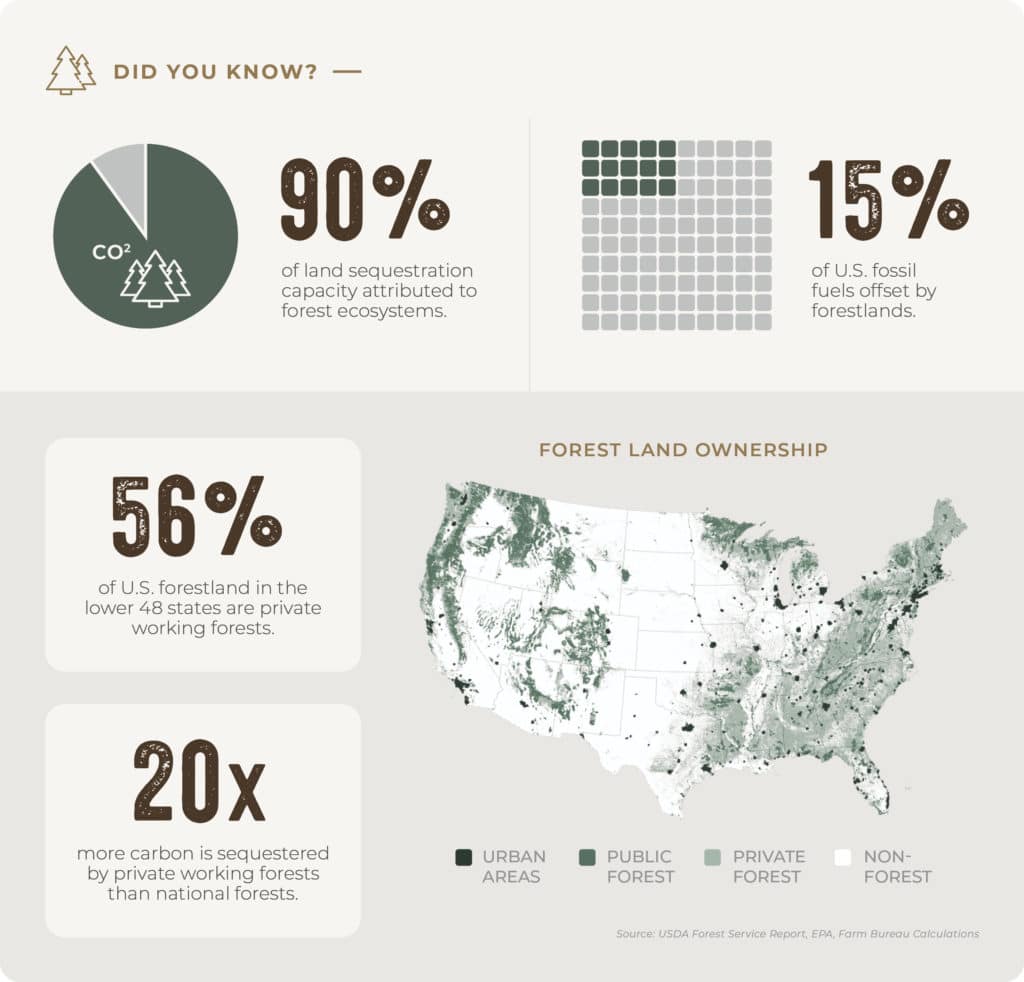The Role of Forest Management in Carbon Sequestration and Private Forest Landowners
As words like “social distancing” and “unprecedented” have begun to slowly dwindle from media headlines, words like “carbon banks” and “net-zero” are quickly filling their place. The consequences of climate change are being felt throughout the globe, from extreme temperature fluctuation to an influx of severe weather events. But it isn’t all bad news. By acknowledging the impacts of climate change, we are taking significant strides in working towards a solution—and agriculture and forestry are a huge part of it.
With Earth Day here and Arbor Day right around the corner, it seems fitting to focus on the single largest carbon capture industry in the U.S.—forestry.
Forest Management and Climate Change by the Numbers

The top ten ranking countries when measuring emissions per capita are as follows:
- Australia: 23 MT
- Kuwait: 22 MT
- Canada: 20 MT
- United States: 19.9 MT
- Russia: 18.3 MT
- Japan: 10.2 MT
- China: 8.9 MT
- EU: 8.4 MT
- Mexico: 5.1 MT
- Brazil: 5 MT
No matter where the U.S. falls on the global ranking for carbon emissions, our nation is poised to lead the way in climate-smart initiatives through research and technological innovation. U.S. agriculture is one of the lowest emitting sectors of major U.S. industries. It is also the only sector with the ability to utilize terrestrial carbon sequestration to offset emissions.

The ocean is the largest carbon sink that exists, but forests are the largest terrestrial carbon sink in the world.

According to the Woods Holes Research Center, the highest rate of terrestrial carbon sequestration occurs in young, growing forests. A hectare (equivalent to nearly two and a half acres) of trees holds up to 50 times more carbon than a hectare of grasses or crops.
Sustainable forestry management increases the ability of forests to sequester atmospheric carbon while simultaneously improving soil and water quality.
Sustainable Forest Management Practices
- Planting new trees
- Tree buffers along waterways
- Thinning and prescribed burning
- Rotational harvesting to regenerate forests
Through proper forest management practices, landowners of working forestlands in the U.S. hold the highest rates of terrestrial carbon sequestration above any other sector. But there is still room for growth. Carbon sequestration through forestry would need to increase ten times to offset total U.S. emissions and make us a net-zero nation, according to recent data cited from American Farm Bureau’s Chief Economist Dr. John Newton.
Looking towards the future, increased sequestration potential lies in the use of advanced engineered wood when building federal infrastructure. Incorporating cross-laminated wood into federal infrastructure creates “carbon balls” that can store carbon within the walls of our infrastructure, all while growing more trees to deepen its carbon sink even further. An expansion of working land programs—such as the Conservation Stewardship Program— and “good neighbor” policies that facilitate proper forest management of neighboring public lands would also further support private forest landowners in their sequestration efforts.
Impact Investing in American Forest Conservation
Agriculture and forestry are among the most vulnerable industries to climate change, yet are also uniquely positioned as an important part of the solution. The impacts of climate change have bulldozed their way into legislation, corporate policy, and investment opportunities.
Investing in our climate doesn’t have to mean sacrificing a healthy rate of return for the betterment of society. Long-term trends of timber land values have remained positive over the past few decades and offer a hedge against inflation that is outside the influence of a fluctuating stock market. AgAmerica offers flexible upfront financing for timber, recreational, and agricultural land. We are a nonbank lender that isn’t confined to the regulations of traditional lending institutions. Because of this, we are able to build customized solutions to help rural landowners seize the opportunity to make a difference with their investment—all while securing a stable asset guaranteed to appreciate over time.
Learn more about how our flexible land loans can help you invest in U.S. forests and our future by contacting us today.






